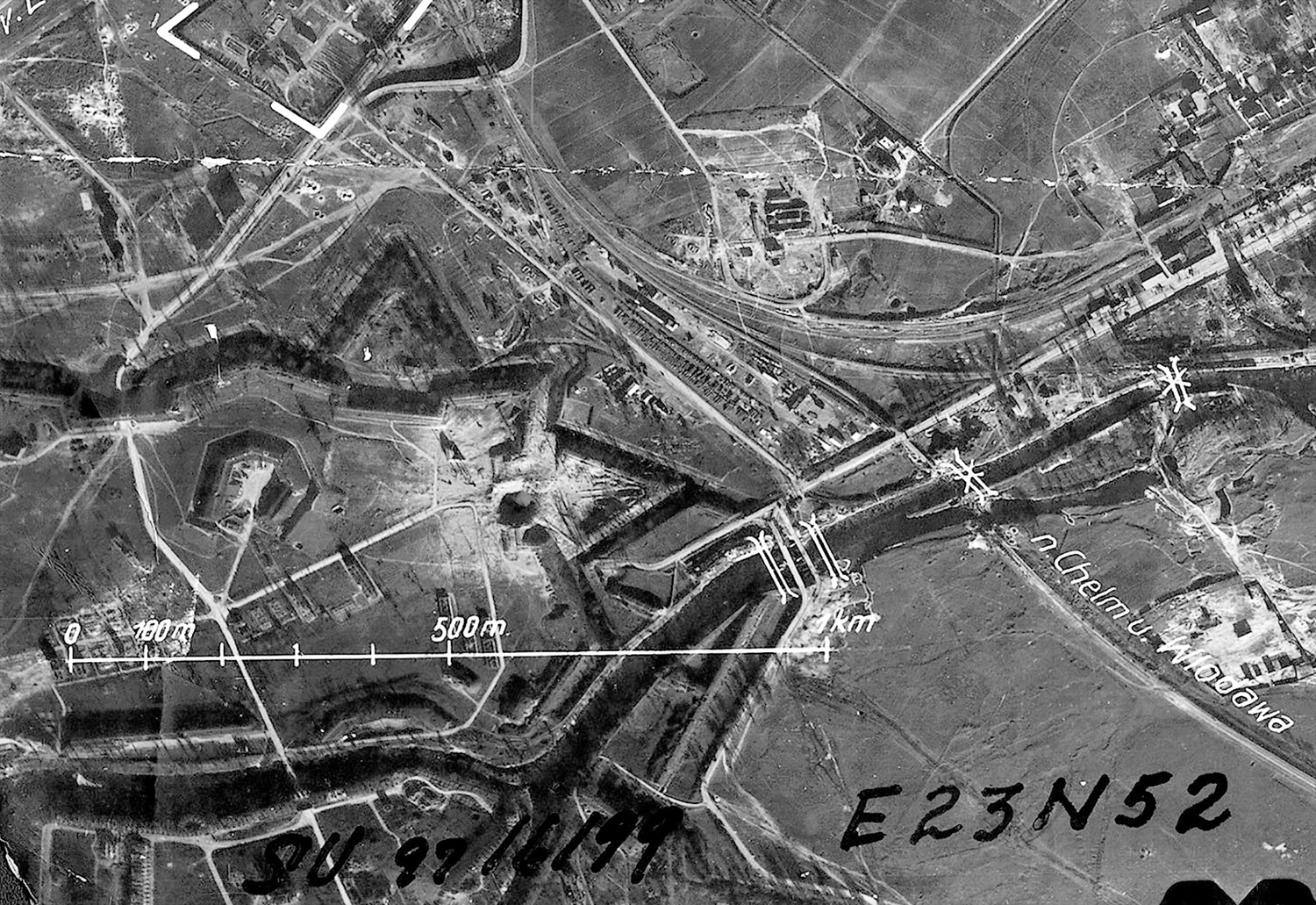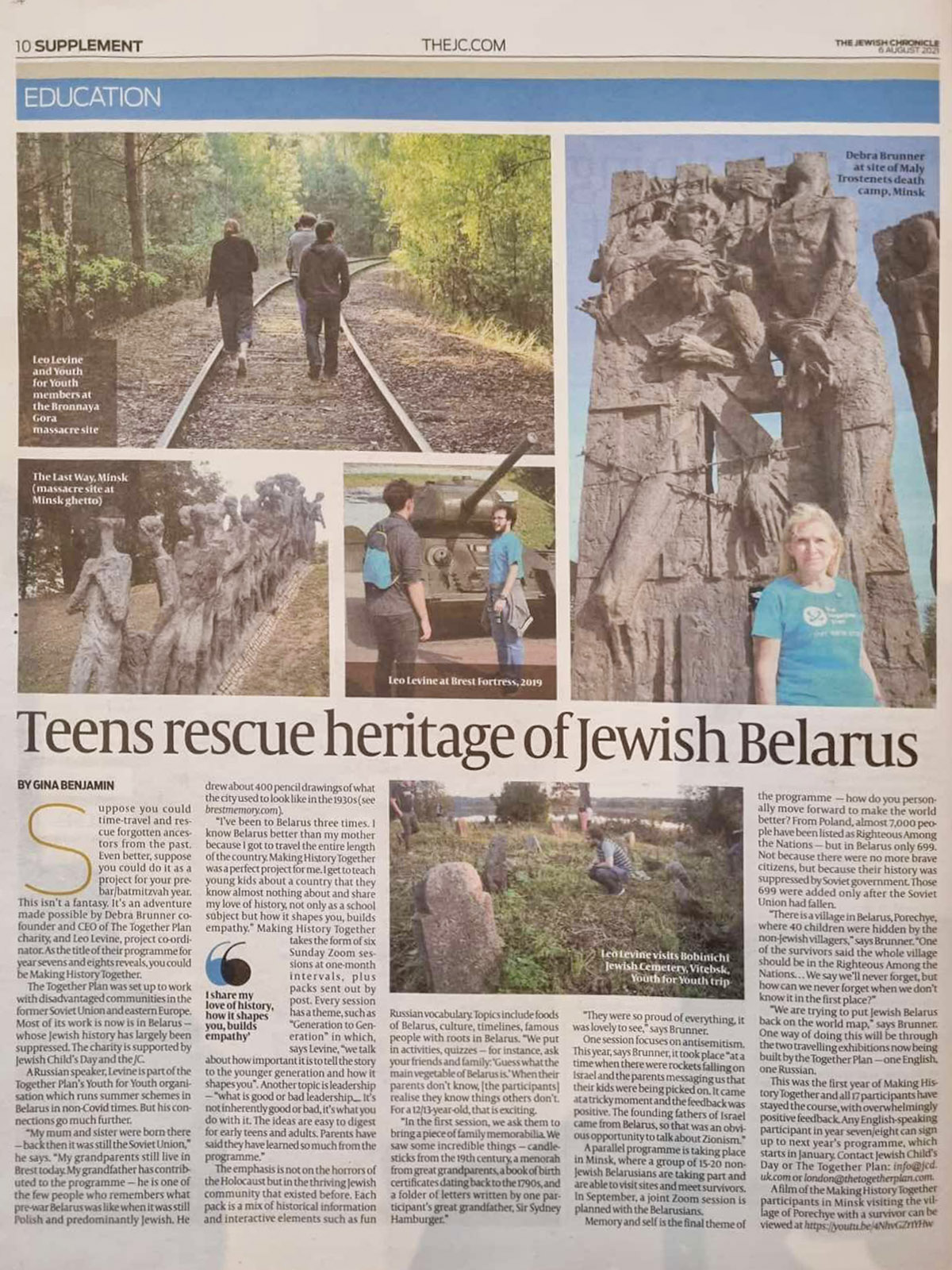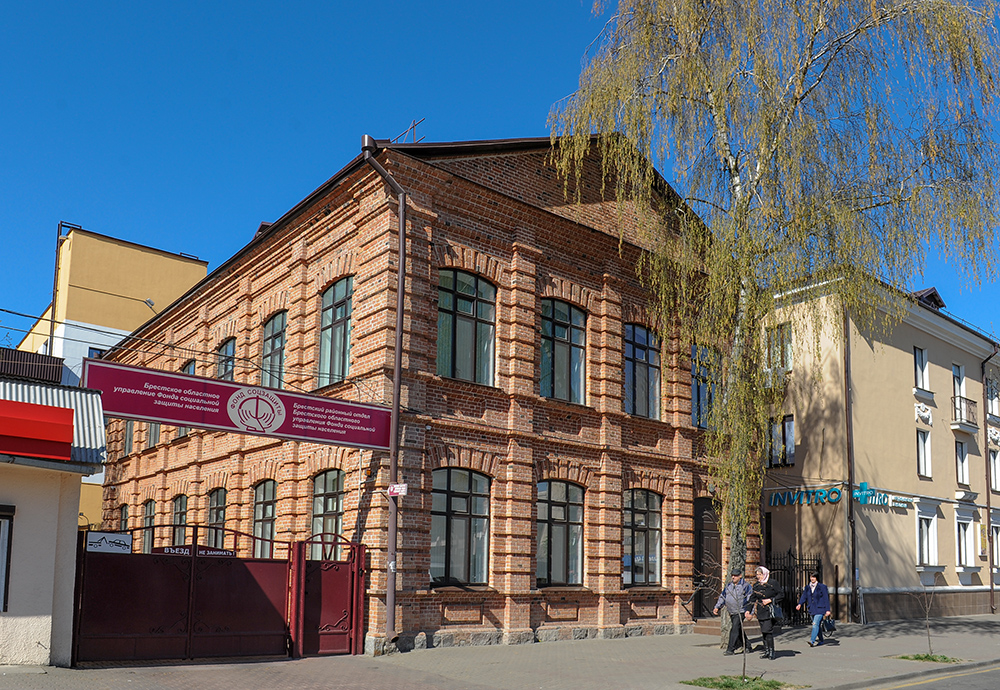Friday 6 August 2021 in the education section of the British weekly newspaper the Jewish Chronicle, an article by Gina Benjamin was published titled “Teenagers rescue heritage of Jewish Belarus”. The events of last year have made Belarus infamous throughout the world. This is on the one hand, but on the other hand, they also raised interest in learning more about Belarus, its history and culture. The British charity The Together Plan has been actively supporting the small Jewish communities still present in Belarus for many years. The organisation pays of attention to educational activities, the purpose of which is not only to preserve the memory of the centuries-old history of Jews, who once lived in Belarus and completely disappeared in the Holocaust, but also to pass this baton of memory to future generations. Last year, a joint Belarusian-British project “Making History Together” was launched. This project, in which teenagers from two countries participate, offers a wide range of topics that are offered to study and discuss for children that show an interest in history, told in an article by project coordinator Leo Levine and director of The Together Plan, Debra Brunner.
The vanished school campus
In May 1941, I finished the 1st form of secondary school No. 5 in Brest. In early October 1944, shortly upon my return from Saratov to Brest, I entered the 5th form of the same school, but now incomplete secondary school No. 5 in Brest. I walked along the familiar, but hardly recognizable streets of Brest to my new school on Kuibyshev St.(formerly Dluga St.). The school was located in the busiest part of the city next to the city bazaar or, as it was called, the Small Bazaar, although actually it was the largest market in the city with its own flea market. Now this place is the bus station square. The flea market occupied the intersection of Kuibyshev Str. and Mitskevich Str.

The “Small Bazaar” in the days of Nazi occupation
The biggest place for admiration was the building of my pre-war school No. 5, the former Russian gymnasium (classical school) named after Tsarevich Alexei, built in 1905. From 1920 to autumn 1939, it housed the Polish gymnasium named after R. Traugutt. The domes of St. Nicholas Church, built in 1906 on the site of an old wooden church that burned down during the fire of 1895, towered over the market and over all nearby houses. The new church was erected using funds raised mostly by parishioners, the Orthodox brotherhood, hence it became better known as the Brotherhood Church.

The building of the Brest boys’ gymnasium built in 1904-1905
My new school was located in the building of the very first Russian gymnasium (classical school) in Brest-Litovsk, built in 1899 on the site of the Brotherhood Church. A small two-story brick building with its windows looked cheerfully to the south – towards the disappeared Bratskiy Lane later and then Shkolny Lane, to the east – to Dluga Street and Kuibyshev Str. From that building further on the school yard stretched to Mitskevich Street. The width of the yard was confined to the wooden church fence and a wooden fence along Kuibyshev Str. and Mitskevich Str. It’s common to perceive what you see for the first time as if it has been existing permanently. This is how I saw the vast schoolyard, when I visited it for the first time on an October day. It was a very large yard. The surface of the courtyard was quite flat, with grass growing only along the church fence. Next to it, an earthwork rose, covering a small bomb shelter with a door constantly locked, and a lonely wooden boom – the only “fresh” structure.

Students of the Brest Russian gymnasium playing near the St. Nicholas Church. Photo from the home album of the Belevets family.
The first Russian gymnasium was built in 1899 on a site that belonged to the Brotherhood Church. Two wooden houses had already been built on it: one along Kuibyshev Street, the second one along the church fence. Subsequently, they were comprised by the complex of gymnasium buildings, which housed the elementary classes of the gymnasium and the kindergarten. Between those two buildings there was a small yard, which was bordered on the north side by a two-story stone house built much later with a facade facing Mitskevich Street. That was a sort of school complex or today it would be called a school campus. By October 1944, there was no trace of these structures, no hint of their former existence, except for one on that school campus.


The building of the Brest Russian gymnasium.
The air raids of the city by Soviet aviation began with increasing force in the spring of 1944. Perhaps, in one of the first raids, the school buildings of the gymnasium were destroyed. Since they were located on the church land under the care of the community, it was decided to clear the site from the ruins, though two buildings survived. In those days, the priest in charge of the Fraternal Church was a graduate of the Russian gymnasium Mitrofan Znosko, who succeeded his father, priest Konstantin Znosko, who died in 1943.

Funeral of Archpriest Konstantin Znosko. Brest-Litovsk, June 1943. It was prohibited to walk through the arched passages of the buildings on the street, which are visible in the photo on the right, as they were leading to the area of the Jewish ghetto, which was guarded even after its prisoners were killed. The photo from the collection of Ivan Chaichits.
During the war, a German hospital was located in the Russian gymnasium in Mitskevich Str. I do not know, who occupied the building of my future school. The buildings of both Russian classical schools and the Fraternal Church miraculously survived the fires of the summer of 1944, but were surrounded on all sides by ruins and conflagrations. After the liberation of Brest, many of the surviving school buildings were occupied by hospitals: the building of the former gymnasium in Mickevich Str., the building of the Jewish school in Pushkinskaya Street, the railway school in Kievka. There were not enough teachers, especially in the Belarusian language. It was incredibly difficult to bring children back to school after the three-year “vacation”. As for the age, those schoolchildren were children, but in terms of their acquired life experience, they were adults, on becoming wise in the struggle for survival.

What is on the site of my school today? Being squeezed on all sides by factory buildings, dormitories, cars today, being abandoned and empty, but not losing its originality, the school building looks like a random old guest at a modern get-together. Being sad and modest, it keeps the memory of the past generations of young people, cheerful young boys and girls, adolescents, toddlers, of all those whom it sheltered, warmed and guided in the years of their lives with hopes and dreams.
from the memories of V. Gubenko
Translated from Russian by Oleg Medvedevski
“Bombochka”

Two years ago, archival documents were published that revealed the “mystery” of the origin of the reservoir nicknamed “Bombochka” (“small bomb”). For some people, it was a real mystery, a reason for speculations and suggestions. The declassified documents showed that the reason for the formation of the picturesque lake was an elementary non-observance of safety rules when working with explosives, causing deaths of people and destruction. V. Gubenko’s memories confirm and supplement the disclosed facts.
“In October 1944, the sound of a powerful blast shook the ruins of the city. The explosion shattered the glass out of the windows in the buildings of the Regional Executive Committee and the Regional Party Committee that had survived the air raids. The blast wave shattered glass out of the windows on the second floor of the railway technical school building, which was three kilometers away from the explosion center. A column of smoke rose over the fortress, where the disastrous explosion happened.
The roar of the explosion made all the students run together with the teachers of our school No. 5 to the schoolyard. The school was located in a small two-story building of a former Russian gymnasium. Our houses at the intersection of Mitskevich Str. and Kuibyshev Str. were close to the city market, the so-called “Small bazaar” and the flea market. The market supplied the townspeople with a variety of products that were displayed in abundance on the shelves of stalls or sold directly from peasant carts. The abundance, variety, and low prices amazed the hungry people who came from the east hence nicknamed “Easterners”, to whom I belonged. During school breaks, we liked to run into the market, mostly to look at tempting yummy things with the difficult feeling of making a choice: which is better to buy – a liter of jarred rotten pears, or a hot “pyza”.
Going out into the schoolyard, we saw people rapidly running from the bazaar as if being blown away like leaves by the wind. In the noise of cries, coming from the scene, I caught panicky screams that surprised me: “The Germans are coming!” What on earth Germans? The front was over 200 kilometers away from Brest, near Warsaw. Weekly operational summaries of the Soviet Information Bureau from the frontline reported on successful, albeit heavy, offensives of the Red Army on all fronts. The Vistula was forced long ago. The captured Sandomierz and Magnuszew bridgeheads slowly but steadily expanded westward, breaking the fierce resistance of the Wehrmacht.
From July 1944 until the end of the war, not a single German aircraft appeared over Brest, there was not a single air raid alert, although Brest, the largest railway junction, was within the reach of German front-line aviation. The panic shouts of the frightened people fleeing from the market square were caused by the memory of another powerful blast 3 years before, when on June 30, 1941, the Germans dropped an 1800-kg bomb “Satan” on the defenders of the East Fort in the Brest Fortress. The city shook, being accompanied with the roar of that explosion and the sound of the shattered window panes of hundreds of city houses. The bazaar crowd, panicked in no time, reacted adequately to the roar of that October explosion which reminded of that in June 1941.
The city authorities did not comment on the incident. The war was going on. The fortress was under the jurisdiction of the military authorities. Naturally, they disclosed to the population just some information that was permitted. At first, we only learned that something exploded in the fortress. Later some details of the events became known.
It was a storehouse with captured German ammunition that exploded. The blast killed a team of 19 soldiers. That was the entire information available in those days, and today – nearly the same. The event soon faded from the memory of the townspeople and was happily forgotten, so for the generations of “post-war boys” it is completely unknown.

In the pre-war time, the Kobrin Gate, now completely forgotten, was the main communication hub connecting the population of the city with the inhabitants of the fortress, its garrison. There was a road called J. Piłsudski Alley crossing the fortress from east to west, starting from the Kobrin Gate and running further into the depths of the fortress. The alley ended at the North-West (Bielsk) Gate. It was quite a busy road, along which there were houses in which families of military personnel lived. J. Piłsudski Alley intersected the 3rd of May Alley, which ran from the Headquarters (Triple-Arched) Gate to the Brest (North) Gate. At the intersection of the two streets there was a small post office, destroyed by the Germans in the fall of 1939. The building collapsed, but its concrete roof with traces of bituminous coating still lay for several decades, without hindering anybody or arousing questions in anybody. The roof remains were removed relatively recently.
A narrow-gauge railway line passed through the Kobrin Gate. The entire rolling stock on the line was comprised of two carriages and a steam locomotive. The narrow-gauge tracks running from the Kobrin Gate, crossed the Moscow highway, skirt the city garden, which was called J. Piłsudski Park. In the vicinity of the river port, the narrow-gauge railway turned to the present-day Lenin Street and ended at the square of the same name. The line was dismantled during the construction of the building of the today’s Regional Executive Committee and other buildings that adorn Lenin Street now.
There was another narrow-gauge railway in the fortress: Brest Central-Citadel. The Poles called it “amunicyjna” because it was for carrying ammunition to the fortress. When this narrow-gauge railway ceased to exist, I do not know, but according to an eyewitness, in the fall of 1939 it was no longer there. To take food out of the captured fortress, the Germans mobilized peasant carts from the outskirts villages and by September 22, 1939 they left empty food storehouses in the fortress to the Red Army. Perhaps this is partly why Guderian was so complacent during the ceremony of passing the city to the brigade commander Krivoshein. The German general cheated the red commander. Although it was a little cheat, but pleasant to the German. As a matter of fact, it was a minor reason for joy. After the Red Army was stopped by the treaty of September 28, 1939 in its movement to the previously agreed demarcation line and came back to the Bug River, it brought everything that was possible and a little more from the Polish cities Luków, Siedlce, Biała Podlaska previously occupied by the Red Army. That was apparent seeing the heavily laden Polish trains standing on all the tracks of the huge Brest railway junction.

Let’s go back to the Kobrin Gate. I haven’t seen it. I saw only what was left on the spot of the explosion. There was nothing left. Piles of broken bricks, miraculously survived remnants of brickwork, a huge gap in the rampart around the fortress – all this indicated the force of the explosion. There was a funnel, or just its outline. It was filled with debris of destruction. Surely right after the explosion, this place looked a little different, because the rubble was dismantled by military teams searching for remains of the victims of the explosion.
 1944
1944
 1941
1941
 2020
2020
 1944
1944
Unfortunately, ignorance gives rise and multiplies numerous legends, myths that have now are treated as fakes. One of these fakes was the legend that “a super powerful bomb hit that place, and that was why the boys after the war called a reservoir with perfectly flat banks Bombochka.” What boys “after the war” gave this name to this place and when “after the war”, nobody cannot say. 73 years after the end of the war, the legend requires no detailed timeline. I can say with full confidence: our generation of “boys after the war” was not and could not name the location of the lake “Bombochka” due to the lack of an object that would match such a name.”
from the memories of V. Gubenko



